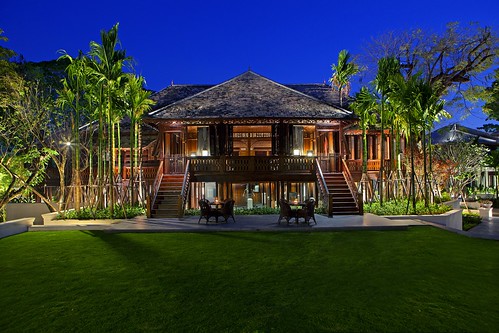Chiang Mai: Pillars of Tranquility

The former royal city of Chiang Mai in Thailand’s mountainous north, rises above the noise from the rowdy south. Roderick Eime escapes the rabble.
“Everything in Siam has its own time”
So said the bold Anna Leonowens to King Mongkut in that famous piece of semi-fiction, “Anna and the King”
And if that time was now, the former Kingdom of Siam has indeed come into its own.
While the southern territories abound in hedonistic pleasures, attracting record tourist numbers, the north retains the charm and beauty that so enthralled the 19th century royal governess. With her precocious son, Louis, the two lived in the King of Siam’s court for six years from 1862. Anna left, never to return, while Louis returned 15 years later to begin an enterprise in the burgeoning teak trade.

He returned to the former seat of the royal family, Chiang Mai, and built a magnificent manor in the traditional Thai style. That residence has now been restored and forms the centrepiece of the superb new boutique resort, 137 Pillars House.
So called because of the number of teak pillars on which the house was built, the immaculately renovated structure now hosts the restaurant, bar and lounge of the property and transports guests back to a time of colonial opulence, when the ways of England were the ways of the world.
Like so many grand old houses around the world, it nearly fell into total disrepair and locals were already calling it Baan Dam, or “black house”. In 2002, Bangkok-born Panida Wongphanlert was looking for a property in which to retire from the frenetic pace of Bangkok. She was shown many sites, but the black house kept haunting her.
“We were charmed at first sight by 137 Pillar House. As we learned the true, fascinating story of this house and the East Borneo Company, we knew our family could share this slice of Thai history with the world,” said Panida at the time.
The restoration involved removing the house from its pillar foundation and building new, concrete ones. During this process odd relics kept appearing; an Edison light bulb, crockery fragments, ornate wood carvings, bottles and even a bath tub. All of these curiosities are now displayed under the main house next to the gym in a kind of ad hoc museum.
The 30 suites stand a respectful distance from the house and were all scratch-built. They range from the 20 entry-level Rajah Brooke Suites at 70 sqm through the six East Borneo Suites (75sqm) to the premium two William Bain Terrace Suites (100sqm) and two Louis Leonowens Pool Suites (135sqm). All display exquisite décor including 400-thread count linen enveloping the four-poster beds and reams of Jim Thompson silk embellishing the walls and windows. Each suite has a private library, espresso machine and party-sized day bed on the balcony or veranda.
The original house hosts The Dining Room, Drawing Room and Jack Bain’s Bar, named in deference to the last owner, whose prominent family preserved the house since the demise of The Company and all foreign traders in 1960, when Thai natural resources were nationalised. Swing by The Spa then take high tea in a wicker chair on the verandah before adjourning for dinner and exquisite contemporary Thai cuisine. Finish the day with a cognac and cigar.
When you’re not immersing yourself in the delights of the resort, there’s the charm of Chiang Mai to absorb, a city that has beguiled westerners since the mid-19th century when the real royal student, King Chulalongkorn, invited the first Europeans to settle in. There’s Jack Bain’s personal project, the Wat Gate Museum with its eclectic assortment of colonial memorabilia and photographs, or the Khar Rham Temple, the spiritual centrepiece of the former ‘foreigners-only’ district.
Across the river, in the former Siamese sector, is the sprawling night markets and shopping precinct. Or further out of town adrenalin junkies can get their fix on the Eagle Track Zipline, venture into a tiger cage or ride one of the majestic elephants at Patara Elephant Farm.
Chiang Mai is also home to the Baan Tong Luang Hill Tribes Village, an eco-agricultural project that attempts to preserve the traditional agrarian culture of the Lahu, Hmong, White Karen and the Long necked Karen people. For many visitors this is the only exposure they will get to these vanishing cultures and while not a perfect example, it is an enlightening recreation all the same.
Life for the bold and adventurous expatriates of 150 years ago was harsh and luxurious in equal measure. While the men would disappear into the jungle for months at a time in search of the valuable timber, the women would occupy themselves with tea, embroidery and gossip. A lot has changed in that time, but Chiang Mai has so far resisted the brash, bawdiness sweeping the south, retaining the regal aura on which it was built.
Although Anna lamented to her royal pupil “You cannot shut the world out forever”, at 137 Pillars in Chiang Mai, a few days may be all you need.
Three comparable resorts
• The Chedi (now Anantara)
• The Four Seasons
• Mandarin Oriental Dhara Dhevi
Trip notes
Getting there
Thai Airways flies 11 times a week from Sydney to Bangkok with daily connections to Chiang Mai. 1300 651 960, thaiairways.com.au.
Staying there
137 Pillars House is a gated urban resort located in the Wat Gate district of Chiang Mai, close to the centre of town, but quiet enough to imagine you are elsewhere.
There are 30 suites ranging from AUD$350.00 (per single or couple) for a 70sqm standard suite up to $1100 for a 135 sqm pool suite.
More information
